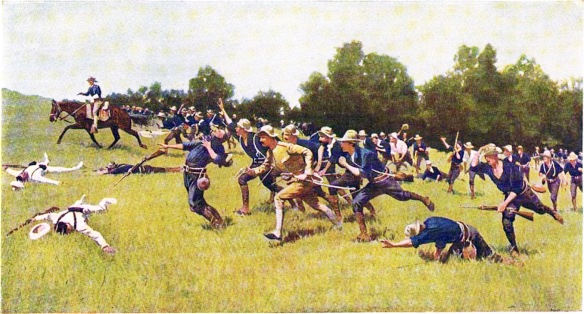Charge of the Rough Riders at San Juan Hill by Frederic Remington. In reality, they assaulted San Juan Heights and the portion later called Kettle Hill by the Americans.
US Army photo taken near the base of Kettle Hill about July 4, 1898. The soldier is pointing up to the top of Kettle Hill. In the background you can see the block houses on San Juan Hill and the American encampment.
Event Date: July 1, 1898
The Battle of Kettle Hill on July 1, 1898, was part of the general U.S. Army assault on San Juan Heights, the last major natural barrier to the port of Santiago, Cuba. Kettle Hill was a smaller elevation, located just before the northern extension of San Juan Heights. U.S. Army V Corps troops, commanded by Major General William R. Shafter, had disembarked some 16 miles east of Santiago at Daiquirí on June 22, 1898. Kettle Hill, held by some 750 Spanish troops, was the first objective before San Juan Heights.
While Brigadier General Henry W. Lawton’s 2nd Infantry Division attacked Spanish troops at the nearby town of El Caney, Brigadier General Jacob F. Kent’s 1st Infantry Division and Major General Joseph Wheeler’s Dismounted Cavalry Division advanced toward San Juan Heights. With Wheeler ill, Brigadier General Samuel S. Sumner had charge of the Dismounted Cavalry Division. Shafter, situated at El Pozo two miles away, had envisioned Lawton’s troops defeating the Spanish troops at El Caney in two hours and then moving south to join Kent’s and Sumner’s divisions for a combined assault on San Juan Heights.
The American attack on San Juan Heights, however, was delayed when Lawton’s troops took longer than the anticipated two hours to quell Spanish resistance at El Caney. The men of the 2nd Infantry Division and the Dismounted Cavalry Division were meanwhile coming under fire from Spanish troops on the heights. After waiting for several hours and taking casualties from Spanish fire from the heights, many of the American officers grew impatient waiting for new orders from Shafter. At 1:00 p.m., three hours after the planned time for the assault and on his own responsibility, Sumner ordered an attack. On the left, Brigadier General Hamilton S. Hawkins’s 1st Brigade of Kent’s division moved up the western slope of San Juan Heights. Receiving important fire support from the Gatling Gun Detachment, they reached the summit.
At the same time that the infantry troops were securing San Juan Heights, Sumner’s dismounted cavalrymen on the right flank were moving up Kettle Hill. The 9th U.S. Cavalry Regiment led the attack, closely followed by the 1st Volunteer Cavalry Regiment (the Rough Riders) and the 1st U.S. Cavalry. Meanwhile, the 3rd U.S. Infantry, 6th U.S. Infantry, and 10th U.S. Cavalry moved partway up the hill.
Lieutenant Colonel Theodore Roosevelt of the Rough Riders was among the first leaders at the top of the hill. He was one of the very few officers to proceed on horseback, but a wire fence had forced him to dismount near the crest and make the last 40 yards on foot. There were no Spaniards there when the Americans made the summit, as they had withdrawn ahead of the American advance. By 1:15 p.m., 15 minutes after the attack began, the Americans were in possession of Kettle Hill. The Americans on Kettle Hill then opened an intense fire on San Juan Hill to the north. Roosevelt secured permission from Sumner and then led his men down the western slope, past a small lagoon, and up the northern extension of San Juan Hill to secure the part of San Juan Heights north of the El Pozo–Santiago Road. The attack cost the Dismounted Cavalry Division 35 dead and 328 wounded. It also made Roosevelt a national hero. He used reportage of his role in the battle to help win election as governor of New York in 1899 and nomination as the Republican vice presidential candidate in 1900. His role in the fight for Kettle Hill was popularized by American journalists and illustrators. New York Sun journalist Richard Harding Davis, the best-known newspaper correspondent of the war, wrote eloquently of Roosevelt’s charge up the hill. Frederic Remington’s painting The Charge of the Rough Riders was even more laudatory of Roosevelt’s heroism. Commissioned by Roosevelt himself, the painting depicts Roosevelt in the background on horseback, pistol drawn, leading the men forward. Although many of the Rough Riders wanted Roosevelt to receive the Medal of Honor, Secretary of War Russell Alger, upset that Roosevelt had written a report demanding the immediate return to the United States of troops suffering from disease, refused to endorse the recommendation. Nevertheless, on January 16, 2001, President William Jefferson Clinton posthumously awarded Roosevelt the Medal of Honor for his actions at Kettle Hill and San Juan Hill. Although the award came more than a century after the deed, Roosevelt was the first president of the United States to receive the highest U.S. award for valor.
Further Reading Azoy, A. C. M. Charge! The Story of the Battle of San Juan Hill. New York: Longmans, 1961. Konstam, Angus. San Juan Hill, 1898: America’s Emergence as a World Power. Westport, CT: Praeger, 2004. Samuels, Peggy, and Harold Samuels. Teddy Roosevelt at San Juan: The Making of a President. College Station: Texas A&M University Press, 1997. Walker, Dale L. The Boys of ’98: Theodore Roosevelt and the Rough Riders. New York: Forge, 1999.
